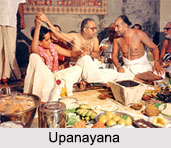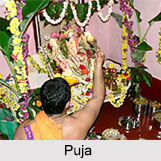 Hindu Rituals are the representations of the Upanishads that continue the work of the Brahmans and Aranyakas in interpreting the meaning of the Srauta ritual. Hindu Ritual occurs in the home, in the temple, at wayside shrines, at places of pilgrimage such as the confluence of sacred rivers, and in specially constructed pavilions. Rituals occur to mark special occasions, to ask for blessings or to propitiate Gods. Ritual patterns constrain life from birth, through childhood, to marriage and finally death.
Hindu Rituals are the representations of the Upanishads that continue the work of the Brahmans and Aranyakas in interpreting the meaning of the Srauta ritual. Hindu Ritual occurs in the home, in the temple, at wayside shrines, at places of pilgrimage such as the confluence of sacred rivers, and in specially constructed pavilions. Rituals occur to mark special occasions, to ask for blessings or to propitiate Gods. Ritual patterns constrain life from birth, through childhood, to marriage and finally death.
The social and political contexts in which Hindu rituals have existed have been diverse, from Hindu kingdoms to colonial rule. Rituals have a persistence which survives great political upheavals, ecological catastrophes and colonial repression. Rituals in Hinduism provide a sense of identity for Hindu communities. Hindus perform rituals of sacrifice and puja to propitiate deities and receive blessings, and some Hindus perform private rituals for the purposes of salvation (mukti) and to experience the pleasures of higher worlds or heavens (bhakti).
Sources of Hindu Rituals
Some ritual forms originated during specific historical periods and reflect cultural and political elements present during those times. In Hinduism, there are traditionally two sources for Hindu rites of passage. On one hand the texts of tradition (smrti), specifically the Grhya Sutras and the Dharma Sutras and Shastras; on the other, the regional oral traditions whose legitimacy was recognized in the Dharma Shastras.
 Various Hindu Rituals
Various Hindu Rituals
The Dharma Shastras deal only with male rites of passage, but throughout India women have undergone rites of passage based on oral folk traditions. For high-caste or "twiceborn" Hindu males - those belonging to the top three classes of Brahmins, Kshatriyas and Vaishyas - the theoretical model of the Ashrama system, the Hindu stages of life, maintains that there are four stages through which a man may pass; the student (Brahmacharya), the householder (Grihastha), the hermit or forest-dweller (Vanaprastha) and the renouncer (Sannyasa) stages. The first two stages are concerned with worldly life, the third stage with a life retired from household duties and the fourth stage with the transcendence of the social world. Most Hindus remain householders and the samskaras are concerned wholly with life as a social being, that is, with the first two stages or states.
While there are a varying number of samskaras recorded in different texts, the important point is that they form a ritual sequence or complete system which expresses the Hindu social order, or dharma. The number of samskaras varies. 40 are recorded in the Gautama Dharma Shastra, though the standard number in the Grhya Sutras is between 12 and 18. The Manu Smriti mentions 13, though 16 tend to be the standard number. They can be divided into prenatal rites, birth, childhood and educational rites, then marriage and death rites. There are 16 standard rites that include;
1. Garbhadharana, the rite of the conception of the embryo or the `infusion of semen` performed at the time of conception;
2. Pumsavana, the rite of `bringing forth a boy` to ensure the birth of a male child;
3. Simantonnayana, the `parting the hair` rite of the woman during pregnancy;
4. Jatakarma, the birth rite;
5. Namakarana, the naming ceremony on the 10th or 12th day after birth,
6. Niskraman; the child`s first outing;
7. Annaprashana, the child`s first feeding with solid food;
8. Chudakarma, the tonsure ceremony during the 1st or 3rd year;
9. Karnavedha, the ear-piercing ceremony around the age of 3 to 5;
10. Vidyarambha, the `beginning of knowledge` when the child learns the alphabet between the ages of 5 and 7;
11. Upanayana, the rite of initiation and investiture of the sacred thread, occurring from the age of 8 up to about 24;
12.Vedarambha, the ritual of beginning the study of the Veda;
13. Kesanta, the first shaving of the beard;
14. Samavartana, the ritual ending of student life;
15. Vivaha, marriage and
16. Antyesti, the funeral ritual.
Puja in Hindu Rituals
Apart from these rituals, there are some pujas in Hindu rituals. Puja is the offering of vegetarian food, flowers and incense to a deity. Puja in Homes would be performed before the icon or the deity installed either in a separate room, in the houses of the better-off, or in the purest room in the house, the kitchen.
Puja in Temples might become very elaborate, with sacred verses (mantra) being uttered by the temple priest (pujari) while the icon is bathed and dressed, and a variety of foods are offered, accompanied by the strong smell of incense and the loud ringing of bells and banging of drums.
 Some of the principal Hindu festivals are Krishna Jayanti, Raksha Bandhan, Ganesh Chaturthi and Dussehra. This is held during Ashwina (September-October) which marks the end of the monsoon. The first 9 days are called Navratri the end of which time the festival to the Goddess Durga, the Durga Puja, occurs, especially in West Bengal. The 10th day of the festival also celebrates the victory of Rama and his monkey army over the demon Ravana. Some other pujas and Hindu rituals are Diwali, Shivaratri, Holi, etc.
Some of the principal Hindu festivals are Krishna Jayanti, Raksha Bandhan, Ganesh Chaturthi and Dussehra. This is held during Ashwina (September-October) which marks the end of the monsoon. The first 9 days are called Navratri the end of which time the festival to the Goddess Durga, the Durga Puja, occurs, especially in West Bengal. The 10th day of the festival also celebrates the victory of Rama and his monkey army over the demon Ravana. Some other pujas and Hindu rituals are Diwali, Shivaratri, Holi, etc.
Mantras in Hindu Rituals
One of the most striking features of all Hindu ritual is the repetition of sacred formulae, usually in Sanskrit, which accompany ritual acts. These are mantras. Mantras are central to the ritual traditions of Hinduism and, indeed, Hindu traditions can sometimes be defined or delineated by the mantras they use. In the orthodox Vedic tradition they have been used to evoke deities, for protection, and to magically affect the world, and in tantric traditions they are themselves regarded as deities, or as embodying the power or energy (Shakti) of a deity.
Thus, there is a wide range of ritual practices within Hinduism which focus on deities, each distinct to its tradition and region. Ritual provides continuity of tradition through the generations.




















